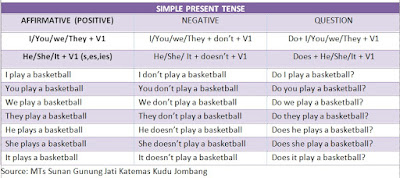Simple Present Tense is used to express an action usually done by someone and the one cannot know when the action will be ended. So, it can be done daily/anytime. it usually uses some time signals such as every day, always, seldom, never, sometime, every....., often, once a week, etc.
sentence pattern.
(+) Subject + Verb 1 (s/es) + Object
(-) Subject + do + not + Verb 1 = Object
(?) Do/Does + Subject + Verb 1 + Object
example:
(+) He reads a novel everyday
(-) He does not read a novel everyday
(?) Does he read a novel everyday?
1. The simple present tense says that something was true in the past, is true in the present and will be true in the future
example:
- Water consists of hydrogen and oxygen
- The average person breathes 21,600 times a day
2. The Simple Present Tense is used to express habitual or everyday activities
example:
- I study for two hours every night
- I get up at seven every morning
3. The Simple Present Tense with a future meaning, we use it when we talk about timetables, programs, etc. (for example: Public transport, cinemas, etc)
example:
- The train leaves Balapan Railway Station at 11.30 a.m. and arrives in Semut Railway Station Surabaya at 02.45 p.m.
- What time does the film begin?
- Air terdiri dari hidrogen dan oksigen
- Rata-rata orang bernapas 21.600 kali sehari
- Saya belajar selama dua jam setiap malam
- Saya bangun jam tujuh setiap pagi
- Kereta berangkat dari Stasiun Balapan pada pukul 11.30 dan tiba di Stasiun Semut Surabaya pada pukul 14.45.
- Jam berapa filmnya dimulai?




No comments:
Post a Comment